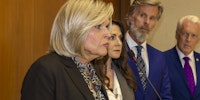begin quote from:https://www.msn.com/en-us/money/markets/fed-announces-another-three-quarter-point-increase-in-interest-rates/ar-AA102htp
Fed announces another three-quarter-point increase in interest rates
With the US economy teetering on the edge of a recession and inflation running at a four-decade high, the Federal Reserve announced another three-quarter of a percentage point increase in its benchmark interest rates on Wednesday, the second such increase in just over a month.
In a statement, the Fed said it was “highly attentive to inflation risks”.
“Recent indicators of spending and production have softened. Nonetheless, job gains have been robust in recent months, and the unemployment rate has remained low. Inflation remains elevated, reflecting supply and demand imbalances related to the pandemic, higher food and energy prices, and broader price pressures,” the Fed said.
The central bank added that Russia’s war against Ukraine is “causing tremendous human and economic hardship” as well as “additional upward pressure on inflation” and weighing on global economic activity.
The US central bank is aggressively raising rates at levels unseen since the mid-1990s as it struggles to tamp down soaring prices, which rose by an annual rate of 9.1% in June, the fastest inflation rate since 1981.
The hike raises the Fed’s cost of borrowing to between 2.25% and 2.5% and is the Fed’s fourth rate increase this year. It comes as central banks worldwide seek to calm price rises with higher rates.
Related video: Federal Reserve raises benchmark interest rate 0.75% (ABC News)
So far the rate rises appear to have done little to rein in rising prices and the costs of everything from food and rent to gas remain high. The Fed will not meet again until September, at which point more economic data will be available, and its decision committee should be better able to see if its policy is working.
One important measure of the economy will be made public on Thursday, when the commerce department releases its latest survey of gross domestic product (GDP) – a broad measure of the cost of a wide range of goods and services across the US economy. Many economists are expecting growth to have slowed for the second quarter in a row – a guide used by many to declare a recession.
Recessions are, however, officially declared by the National Bureau of Economic Research (NBER), a research group that uses a broad range of measures including jobs growth to decide when the US economy is shrinking. The NBER often makes its announcement well after a recession has begun, as it assesses other economic factors.
Jobs growth remains strong – the US added 372,000 jobs in June and the unemployment rate stayed low at 3.6%.
But, for many, two months of declining GDP is a strong indicator that the economy is in a recession. Michael Strain, director of economic policy studies and senior fellow at the right-leaning American Enterprise Institute, pointed out this week that all of the last 10 recessions in the US have been preceded by two consecutive quarters of negative economic growth.
With midterm elections approaching and the Biden administration facing a tough fight to retain control of Congress, the economy has become the central battleground.
Last weekend the treasury secretary, Janet Yellen, argued that the US is not yet in recession and pointed out that consumer spending and the jobs market remained healthy. “This is not an economy that’s in recession,” she told Meet the Press. Yellen said the economy is “in a period of transition in which growth is slowing”, from a historically rapid pace in 2021.
But Republicans have seized on the confusing economic data to blame the Biden administration for the slowdown, accusing the Democrats of “redefining recession and downplaying the red flags in the economy” in an “attempt to deny the cruel economy they’ve created”.




No comments:
Post a Comment